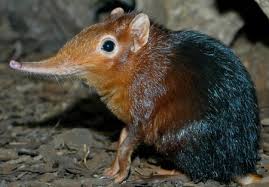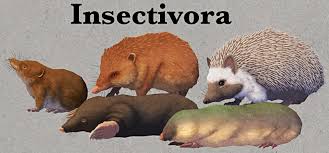The insectivores are primitive insect-eating mammals which occur in most parts of the world other than Australia and South America. They are small (less than 1kg in weight) with short limbs, four or five unspecialised digits on each foot, an elongated nasal region, and characteristic teeth adapted for holding and crushing invertebrate prey. The following families are represented in Nigeria.
• Soricidae (shrews have soft dense pelage). They are the commonest insectivores.
• Tenrecidae (Otter-shrews, have soft dense pelage)
• Erinaceidae (Hedgehogs, have thickened hairs which form spines on the dorsal surface of the body).
The majority of the insectivores are shrews. They are mostly solitary. It is rare to see more than two individuals together outside the breeding season.
African Giant Shrew (Crocidura flavescens)

Identification: One of the two largest shrews in Nigeria; only the black giant shrew is (usually) slightly larger. Dorsal and ventral pelage dark smoky-grey to ginger-brown in Southern Nigeria; pale grey in Northern Nigeria.
Tail thick at base tapering towards tip, relatively long with scattered white hairs; about 70% HB. Very strong musky secretions give a distinctive and rather unpleasant smell. Skull large and heavy, flat in profile.
African giant shrews are rarely found in the rainforest and natural savannah. In other words, they are common in man-made habitats and less common in natural habitats. The litter size is usually four young.
Read Also: Order of Primates: Species, Characteristics and their Economic Importance






